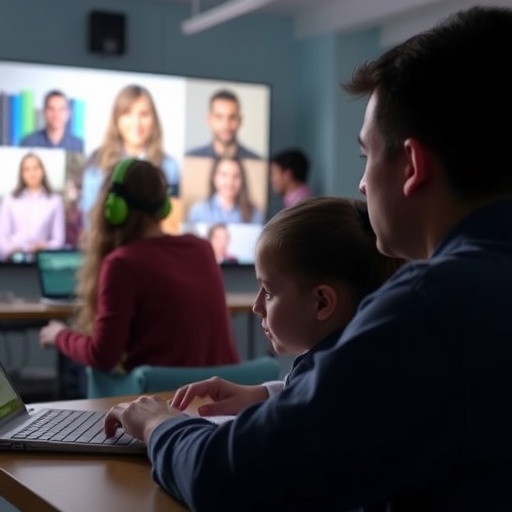In a groundbreaking fusion of eye-tracking technology and artificial intelligence, researchers at The Ohio State University have unveiled promising insights into how children learn from educational videos. This innovative study, involving nearly two hundred young children, marks a significant step toward dynamic and personalized learning experiences, potentially transforming educational content delivery in real time.
The multidisciplinary team, led by associate professor Jason Coronel, embarked on a mission to pinpoint the precise moments within an educational video that captivate children’s attention and enhance their cognitive absorption. By meticulously analyzing eye movements of children aged four to eight as they engaged with science-oriented video content, the study aimed to decode how visual attention correlates with knowledge acquisition.
Central to the research was an immersive four-minute video sourced from popular children’s educational series “SciShow Kids” and “Learn Bright,” focusing on the biological concept of animal camouflage. As the young participants watched the video, state-of-the-art eye-tracking devices recorded their gaze patterns with millisecond precision, capturing fine-grained data on where and when their attention shifted.
Post-viewing assessments evaluated each child’s grasp of camouflage concepts, revealing intriguing correlations between eye movement patterns and learning outcomes. The AI-driven analysis identified several pivotal segments in the video—referred to as “event boundaries”—where shifts in gaze significantly predicted whether children correctly answered comprehension questions. These event boundaries were conceptually aligned with moments in the video when the narrative transitioned, elucidating new information or introducing visual aids designed to consolidate understanding.
One of the most compelling findings emerged from the early segment of the video, where the host invited children to aid in locating an anthropomorphic character named Squeaks. Machine learning algorithms determined that children who visually tracked this cue exhibited heightened engagement, which was strongly predictive of their ability to comprehend subsequent, more abstract scientific concepts introduced later in the lesson. This suggests that early focused attention acts as a cognitive primer, preparing the brain to assimilate complex information.
The research also underscored the significance of explicit definitions paired with visual stimuli: when the narrator defined camouflage and simultaneously displayed the term on screen, children’s eye movements became more synchronized, indicating elevated attentional engagement. These findings emphasize the value of integrating carefully timed multimodal cues—verbal and visual—to anchor learning experiences effectively.
While the study’s results are preliminary, they chart an innovative path toward “real-time” educational feedback systems. Coronel envisions a future in which AI-powered algorithms interpret live eye-tracking data to ascertain a learner’s comprehension status instantaneously. In such a scenario, educational videos could adapt dynamically—altering explanations, providing alternative examples, or modifying difficulty—thereby tailoring learning to individual needs much like a personal tutor.
This vision leverages the rapid advancements in affordable eye-tracking hardware and sophisticated machine learning frameworks. As these technologies become more accessible, the potential to revolutionize remote and classroom learning grows exponentially, offering educators new tools to monitor and enhance student understanding continuously, rather than relying solely on post-lesson tests.
Furthermore, the integration of bio-sensing data with temporal analysis, as advanced by this research, enriches the theoretical frameworks of multimedia learning. It extends beyond static assessments by considering the temporal dimension—when in a dynamic narrative learning occurs—thus enabling the design of educational content informed by cognitive event segmentation theory.
The implications reach far beyond natural sciences or early childhood education. Similar methodologies could be applied to myriad other disciplines where bespoke learning paths are advantageous, including language acquisition, mathematics, and critical thinking skills development. The promise is an educational ecosystem where data-driven insights empower the creation of optimally engaging and instructive content that responds fluidly to learner feedback.
As machine learning models continue to refine their predictive capacities, they may uncover subtler patterns within eye-tracking data, such as micro-saccades or blink rates, further illuminating cognitive states spanning curiosity, confusion, or mastery. These nuanced biosignals hold the key to creating truly empathetic educational technologies, fostering not just knowledge retention but deeper understanding and curiosity.
Nonetheless, challenges remain. The ethical deployment of real-time monitoring, safeguarding children’s privacy, and ensuring equitable access to emerging technologies must accompany these advancements. Researchers emphasize the preliminary nature of their findings and advocate for broader, longitudinal studies to validate and expand upon these results.
In conclusion, this pioneering study stands at the convergence of cognitive science, machine learning, and educational technology, offering a tantalizing glimpse into a future where learning is personalized and dynamic. By harnessing the subtle cues of eye movements and embedding them within AI frameworks, educators and technologists together are poised to redefine the landscape of science education and beyond.
Subject of Research: How children learn science concepts from educational videos through analysis of eye-tracking and AI.
Article Title: Fusing theory-guided machine learning and bio-sensing: considering time in how children learn science from dynamic multimedia
News Publication Date: 5-Aug-2025
Web References: http://dx.doi.org/10.1093/joc/jqaf036
References: Journal of Communication, Advance Article, DOI: 10.1093/joc/jqaf036
Keywords: Eye tracking, Artificial intelligence, Educational videos, Children’s learning, Machine learning, Multimedia learning, Event boundaries, Science education, Personalized learning, Cognitive engagement




